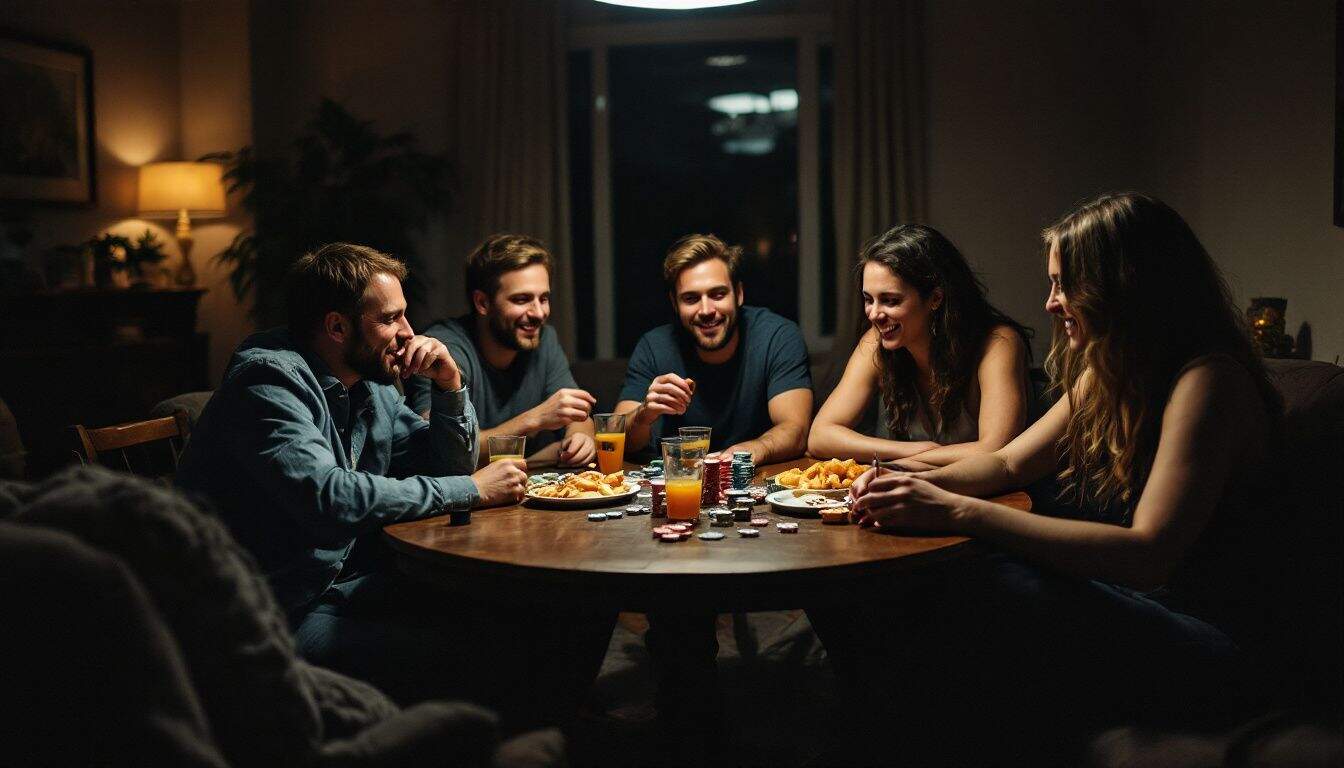Want to have friends over but not sure how to host a poker night they’ll enjoy? Over 60 million Americans now regularly play poker, making it one of the most popular home games. This guide shares clear steps—planning your event, picking fun games like Texas Hold’em and Omaha, setting house rules, arranging snacks and drinks—to help you throw a winning game night everyone will love.
Read on for your best poker night yet!
Key Takeaways
Poker nights are growing popular, with over 60 million Americans regularly playing poker at home in 2025; the most loved games for casual gatherings include Texas Hold’em and Omaha.
A group of around 8 guests is ideal for smooth play; hosting monthly on a fixed date (like the third Friday) helps everyone plan easily.
Comfortable seating around a table with good lighting, quality clay or ceramic chips (at least 500), two durable card decks, snacks like wings and chips, plus moderate background music help maintain an enjoyable mood.
Assigning a clear dealer—rotating among players or hiring one—and setting clear house rules about betting limits ($10-$20 buy-ins recommended) keeps gameplay engaging but relaxed.
In 2025, hosts will likely use mobile apps such as “Band” to simplify guest invites and attendance planning, creating distraction-free gaming spaces that give friends an authentic casino experience.
Table of Contents
Planning the Poker Night
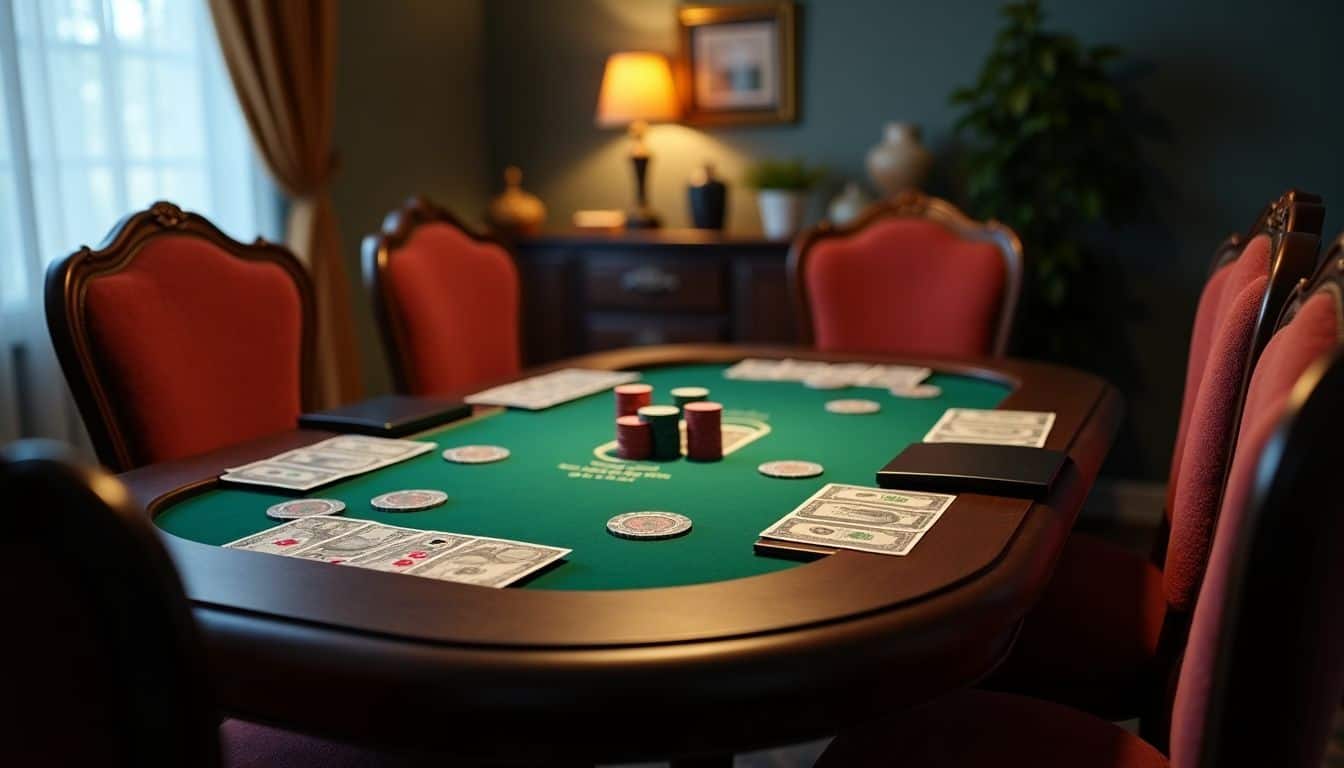
A great evening of Texas Hold’em or Seven Card Stud starts with thoughtful planning—good poker nights don’t just happen by chance. Set the groundwork early, and your cash games will run smooth from start to finish.
Choosing a Date and Time

Choose a date that works for your guests, avoiding holidays or major sporting events like the Super Bowl. From first-hand experience, Friday or Saturday evenings after work hours are popular choices—players can relax and enjoy poker games without stress.
Clearly set a start and an end time, so everyone knows how long poker night lasts; 7 PM to midnight often suits most men well.
If you’re hosting regularly, pick the third Friday of every month—it makes planning poker night easier for you and your friends alike. Send out invites early with reminders about cash game buy-ins, rules of poker variants like Texas Hold’em or Seven-Card Stud, plus snacks and beverages on offer.
It’s also wise to check if regular guests have favorite online activities beforehand—like playing online poker and other casino games—to match their gaming style at home during breaks in action.
Now let’s move onto deciding who makes the cut for your guest list!
Deciding the Guest List
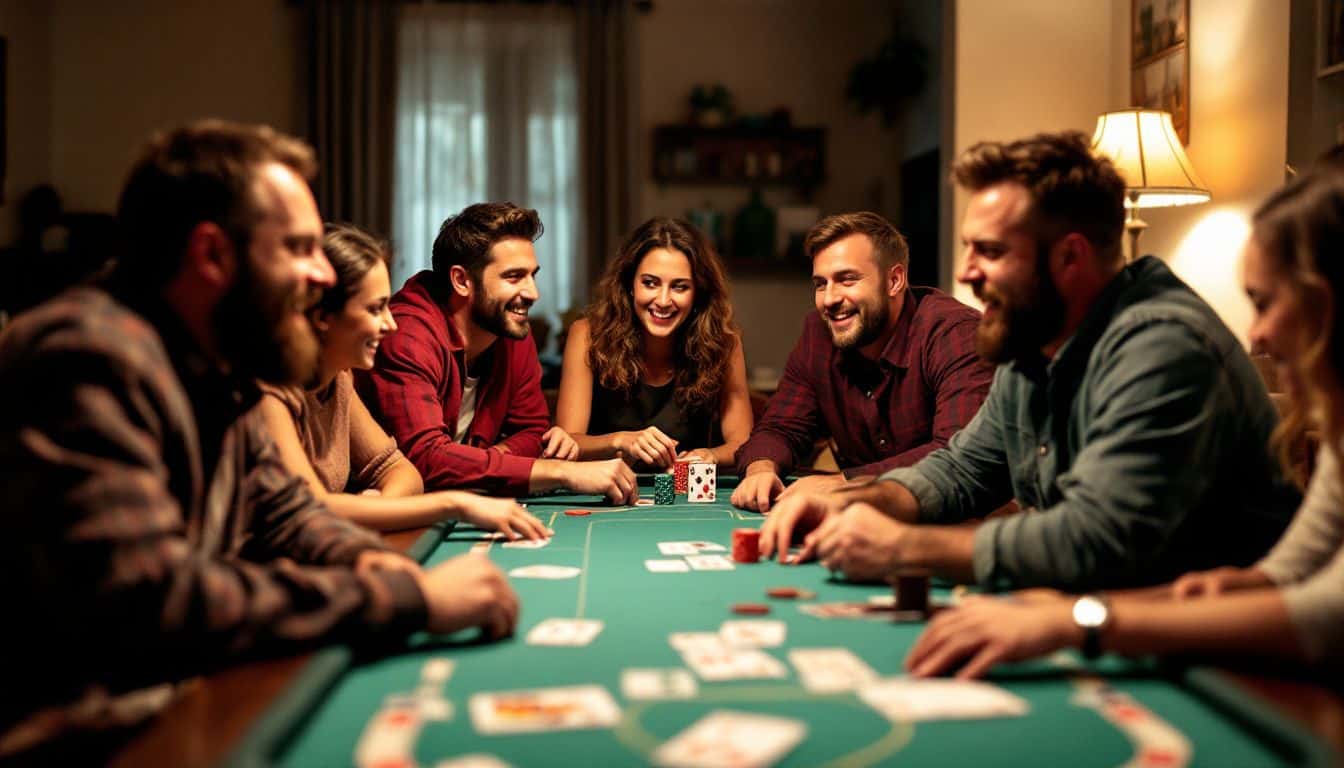
Invite friends, family, or colleagues who like poker or are eager to learn the game. Aim for about 8 guests—this number keeps gameplay smooth and active so no one has to wait too long between turns at the poker table.
It’s helpful to mix skill levels; include both seasoned Texas Hold’em fans and beginners still learning when to fold or make a bet. This variety helps keep things exciting, encourages friendly competition, and makes sure everyone feels comfortable joining in—even those new to this classic card game.
Sending Invitations
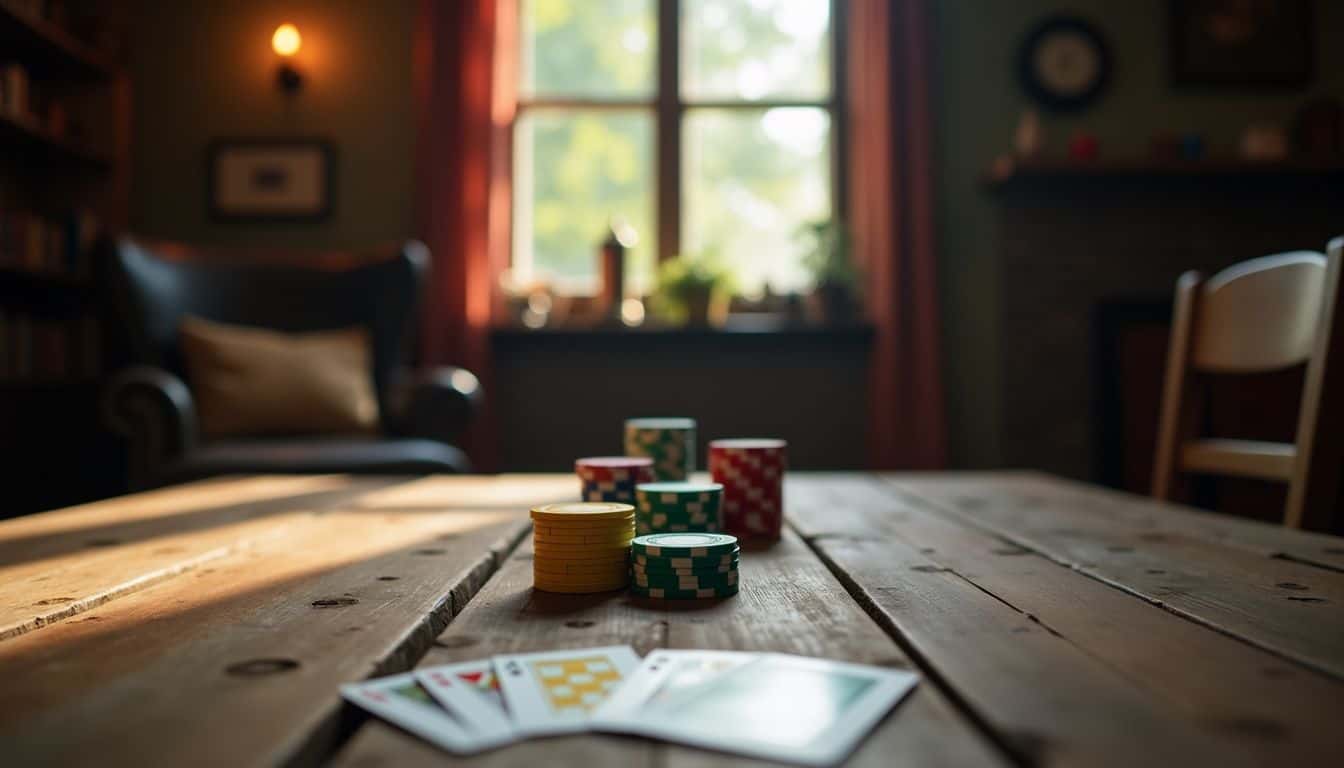
Once you’ve nailed down your guest list, it’s time to spread the word. Email is quick and easy, but physical invitations add a personal touch—especially if you’re hosting poker night for close friends.
List the basics: date, start time, location of play (like your den or basement), and clear RSVP info. Include details about snacks, beverages, game rules like Texas Hold’em or Five Card Draw, buy-ins and stakes—and even mention if there’ll be jazz music playing.
Follow up with reminders one week before and again two days ahead of game night so everyone stays on track.
A great poker night starts with clear invites—no bluffing.
Setting Up the Poker Space
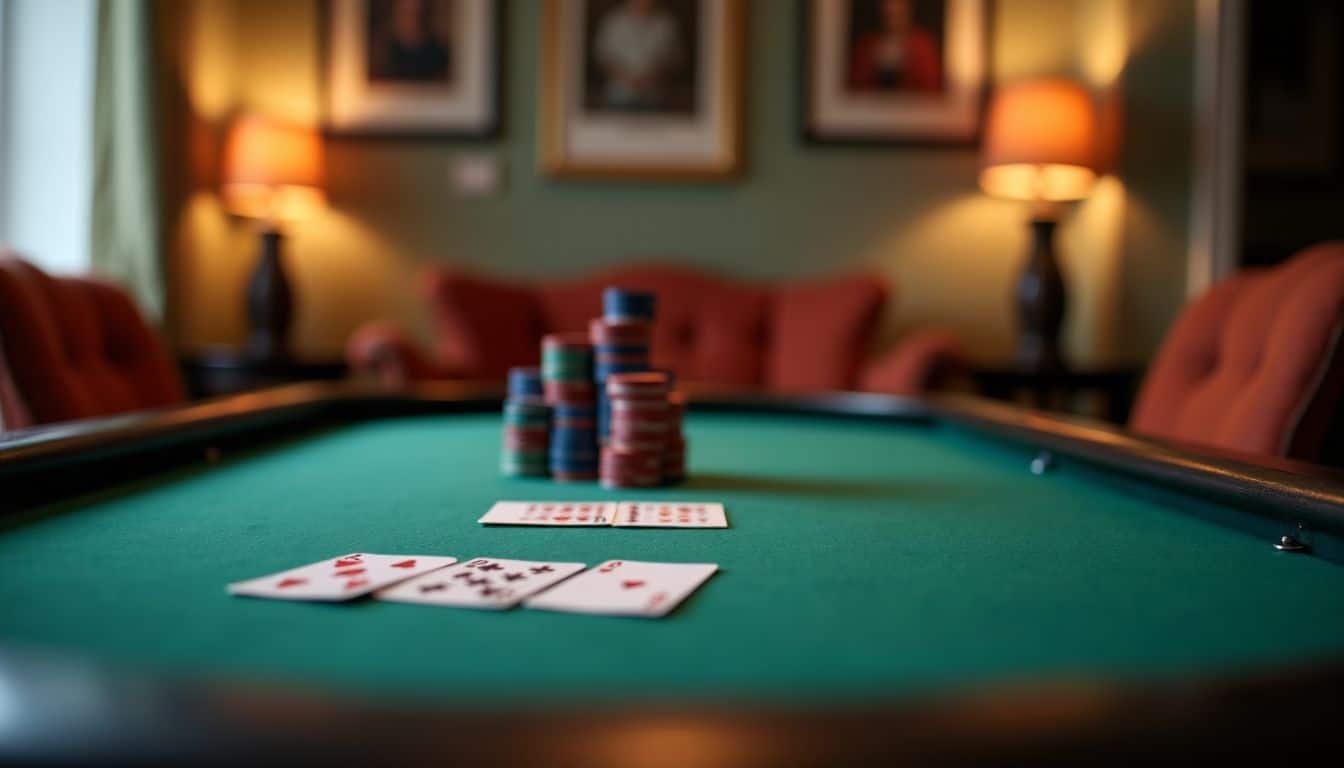
The right table, comfortable chairs, and good lighting help guests relax—and keep the poker chips and playing cards visible. Thoughtful poker night planning creates a welcoming mood from the start.
Selecting a Suitable Table
A poker table sets the stage for a successful game night. Opt for a dedicated poker table, like the Dresden gaming table, if your space and budget allow—it creates the perfect atmosphere, offers built-in spots for drinks, and makes dealing cards smooth.
If that’s out of reach right now, choose an affordable option: top your dining room table with a folding felt topper or padded mat; it prevents playing cards from sliding around and gives easy handling of poker chips during betting rounds.
Make sure there’s enough elbow room—plan on at least 18 inches per player to avoid cramped games. From personal experience hosting weekly poker nights, nothing spoils fun quicker than bumping elbows or knocking over someone’s drink mid-game.
Ensure comfortable seating matches your chosen surface—relaxed players stay longer and enjoy themselves more fully through big blinds, shuffles by the dealer (or handy card shuffler), and friendly banter across decks dealt all evening long.
Arranging Comfortable Seating
Choosing comfy chairs can make or break your poker night. Use seats with good back support—like cushioned dining chairs—to keep players comfortable during long rounds and poker strategies.
Place them in a circle or semi-circle, so everyone interacts easily; this also helps the poker dealer manage the game smoothly.
Leave enough space between chairs to avoid crowding at the table. Around two feet for each player works well if you have room to spare. Players need some elbow room when handling shuffled cards, stacking poker chips, enjoying tasty poker night snacks, and drinking their beverages.
Comfort is key; sore backs never bluff well.
Ensuring Proper Lighting
Good lighting sets the mood for a thrilling poker night. Select a well-lit room, and adjust the light fixtures to cast suspenseful shadows during key game moments—such as tense showdowns or risky bluffs.
Bright yet controlled lighting helps everyone clearly see cards, poker supplies like chips, decks of cards, shufflers—and keeps gameplay smooth. Dimmer switches are a neat trick; they let you easily change brightness levels without hassle.
Position lamps above your suitable table, so no harsh glares hit players’ eyes or create distracting reflections on drinks and snacks (especially if you have glossy poker tables). Good visibility also supports proper poker etiquette—it prevents confusion over stakes, buy-ins, bets placed by each hand—or rake amounts collected at pots throughout gameplay.
Preparing Poker Supplies

Gather quality poker chips, fresh decks of playing cards, and handy extras like automatic card mixers—these basics help your night run smooth (and there’s plenty more to cover below!).
Poker Chips
High-quality poker chips improve the experience—so invest in durable ones made from clay or ceramic. Plan for at least 500 chips, using clear and basic color values; white at $5, blue worth $10, red marked as $20, and green valued at $40.
Stack them conveniently around your poker table to keep play running fast and smooth. Good chips help everyone track bets easily and follow poker rules without confusion.
Quality chips make each game feel like a pro event.
Decks of Cards
Poker chips set the mood, but decks of cards keep your game moving smoothly. You should have at least two card decks ready—this saves time and prevents delays if a card gets damaged or marked.
Choose durable playing cards from trusted brands like Bicycle, Bee, or Copag; these last longer despite frequent shuffling on poker night. I once made the mistake of using cheap dollar-store sets—the cards bent easily and ruined our flow every few hands! Quality playing cards make dealing seamless and boost players’ confidence when chasing down the best hands in poker.
Store extra decks close to your table alongside spare poker night beverages, so they’re within reach during play without pausing action.
Additional Accessories (e.g., card shufflers)
Along with extra decks of cards, having a card shuffler at your table makes gameplay fast and easy. Using an electric shuffler saves time between hands and keeps the game fair for all players—no more worries about uneven deals or delays.
A dealer chip helps show clearly whose turn it is to deal next, making transitions smooth. From my experience, these simple tools ensure fewer pauses and more action-packed poker fun on game night.
Establishing House Rules

Clear rules keep poker night smooth and fair, so pick your game styles and betting limits ahead of time. The right buy-in, stakes, or chip values help everyone relax at the table and enjoy playing cards together.
Deciding Game Variants
Picking fun poker variants keeps everyone engaged and excited to play. Popular options include Texas Hold’em, Omaha, and Seven-card Stud—these games are easy to grasp, fast-paced, and perfect for friendly competition.
Limit your night to one or two game types at most; choose Texas Hold’em if your pals want something simple yet strategic, or go with Omaha for a twist that adds an extra challenge.
Clearly define stakes ahead of time, so guests know exactly what they’re betting each round. Be specific about the rules before starting hands: explain blinds in Hold’em or ante amounts for Seven-card Stud games.
Poker nights run smoothly when players can focus fully on cards—not confusion over unclear rules or mixed signals around bets—which brings us naturally into determining buy-ins and stakes next.
Poker takes minutes to learn, but a lifetime to master. – Mike Sexton
Determining Buy-Ins and Stakes
Set stakes clearly to boost the fun and limit stress. Guests need a comfortable buy-in amount, not too high to worry about losing cash. Group poker stakes into three ranges—low, medium, and high—which makes the choice simple for your group.
For example, low-stakes cash games often use blinds of $0.25/$0.50 with buy-ins between $10-$20; just right if friends want laid-back play without big losses or tension at the table.
Mid-range or higher stakes would suit players who like bigger thrills and risk more easily in comfort—but always discuss these amounts openly before setting them firm. Open talk keeps everyone’s limits clear, so no one ends up uncomfortable once cards hit the felt.
Next step is making sure everyone enjoys themselves even beyond chips and cards—with tasty bites, drinks on ice, music playing—and maybe a theme to liven things up!
Fostering a Fun Atmosphere

Create a relaxed setting with tasty finger foods, cold drinks, and upbeat background music to keep the energy up. Add some fun by choosing a playful theme or simple dress code to get everyone in the spirit of poker night.
Providing Snacks and Drinks
Fill the snack table with easy-to-eat finger foods like crunchy tortilla chips paired with creamy dips, salty mixed nuts, and hot wings. These ready bites help your guests focus on their poker hands without messy interruptions—I’ve seen hungry players drop cards while juggling big plates.
Keep plenty of cold drinks handy, too: stock a mix of beers and sodas, but offer some bottled water or mocktails for guests who prefer non-alcoholic choices. A refreshed player keeps his head clear at the poker table—and that’s exactly what you want heading into setting the tone with music.
Setting the Tone with Music
Tasty snacks and cold beers make your poker night great, but music sets the mood. Choose background tunes that fit a casual vibe—jazz playlists from Pandora or Spotify work well to create a laid-back feel during your game.
Keep volume levels moderate, so players can chat easily without shouting over loud tracks. A good mix of melodies adds just enough energy and style, making guests feel relaxed and into the cards, enhancing everyone’s overall experience around the poker table.
Adding a Theme or Dress Code
Setting a fun theme creates the right mood for your poker night. You could pick a classic Las Vegas Casino vibe, complete with colorful chips and lively music—or maybe style it after an iconic movie like James Bond’s “Casino Royale.” Encourage guests to get into the spirit by dressing up in sharp casino attire such as suits, bow ties, or dress shirts paired with dark jeans.
A clear dress code adds excitement and boosts everyone’s energy. Guests will also enjoy snapping photos of their classy outfits and sharing memorable moments online.
Managing the Game Flow

Smooth gameplay keeps everyone relaxed and engaged, so think about having a dedicated card dealer to handle the chips and cards. Also, keep an eye on timing—this way, no player gets bored waiting for their turn.
Assigning or Hiring a Dealer
A skilled dealer sets the pace and keeps poker night fun for all players. For a casual game with friends, rotate the dealing role each hand—it’s easy if everyone knows the basic poker rules.
But in bigger or more serious games, appoint one knowledgeable player to keep an eye on chips, bets, card shuffling, and enforcing house rules. If your group prefers relaxing over managing cards and chips, hire a dedicated pro from local event staffing services like Party Dealers USA—they handle everything neatly and quickly while you enjoy yourself fully.
After arranging your dealer setup clearly, it’s time to focus on tracking progress throughout the game.
Keeping Track of Game Progress
Use a clear sign-in sheet to track players at your poker night. This helps you know who’s playing and makes sure everyone understands house rules. I have found it saves time by clearly showing who is still in the game—and who needs extra tips or help.
Track changes in game levels with a simple digital timer or mobile app, like Poker Timer Pro. It will beep when blinds should increase—no guessing needed—and keep your evening running smooth and fun.
With this set up, you’ll handle re-buys and add-ons easily as the stakes rise during your event.
Allowing Re-Buys and Add-Ons
Keeping track of bets, blinds, and chip counts helps keep your poker night running smoothly—so allow clear rules for players to re-buy or add-on chips. Set a fixed limit right from the start; allowing two or three re-buys per player works well.
Explain these limits at the game’s outset, so every guest knows what to expect. Re-buys let men who go out early jump back into action and stay engaged instead of just watching from the side.
Add-ons also offer an exciting twist near the end, letting guys boost their chip stacks one final time during a set break in play—which ramps up competition as you get closer to finding your night’s champion.
Poker Night Etiquette
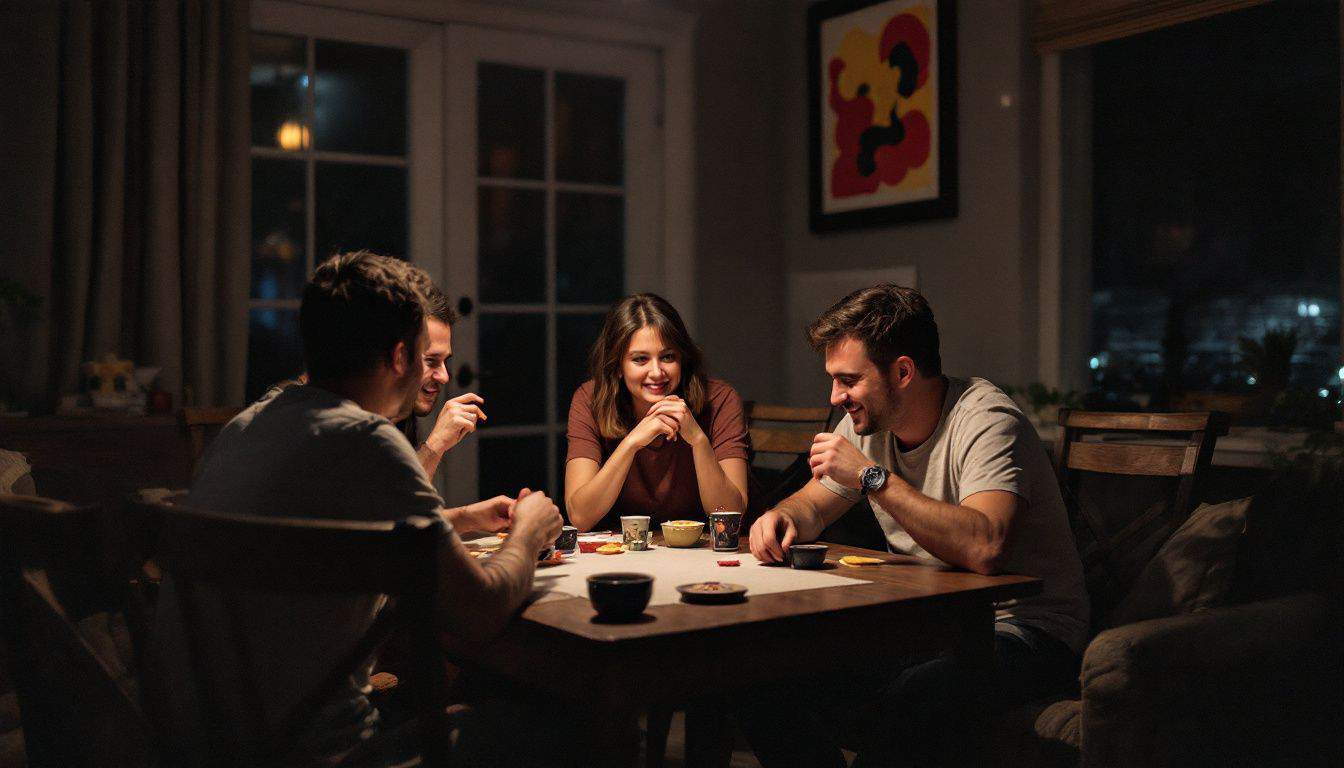
Keep the vibe casual and friendly by encouraging good sportsmanship, respecting house rules, and managing disruptions smoothly—there’s even more to discover about hosting like a pro!
Encouraging Respectful Behavior
Set clear ground rules at the start to encourage respectful behavior among players. As a host, I’ve found that negative talk and harsh teasing spoil the fun fast—keeping moods positive helps everyone enjoy themselves more.
Good sportsmanship makes poker night relaxed and friendly, so lead by example: be polite, calm disputes quickly, and remind others gently if tensions rise. Also, learning how to read people in poker can help you spot early signs of irritation or frustration before things get heated.
This ensures your games remain easy-going social events rather than tense competitions or arguments.
Creating a Smoking Area (if needed)
Choose a spot for smokers—ideally outdoors—to keep the air fresh inside. A simple setup like a patio, deck, or balcony works great. Give guests clear rules about when they can step outside during the poker game so it won’t disrupt play.
Setting up chairs, ashtrays, and even side tables helps your friends relax comfortably while enjoying their smoke break. After all, it’s not just about keeping indoor air clean; guests who smoke will also appreciate having their own space to kick back.
Next up is maintaining a casual and friendly environment at your poker night to ensure everyone has fun.
Maintaining a Casual, Friendly Environment
A casual, friendly poker night is key to making your guests comfortable and games enjoyable. Set affordable buy-ins, around $10 or $20, so no one feels left out or anxious about losing big money.
Good sportsmanship matters a lot—jokes are great, but teasing too much can spoil the mood fast. From hosting regular Friday night games with friends in my basement to joining public tournament events at local bars—I’ve learned that respect always sets the tone for fun.
Set clear yet relaxed house rules before cards hit the table; it’ll help players feel confident without pressure of serious competition. Encourage chatting between hands and break periods—that builds bonds off-table as well as on it—and keep stakes modest enough for everyone to laugh off losses easily.
After all, you’re there mainly for laughs and friendship—not just chips won! With smiles and easy-going vibes set firmly in place throughout gameplay sessions ahead… it’s time now for post-game cleanup tips you won’t want to miss!
Post-Game Cleanup and Follow-Up
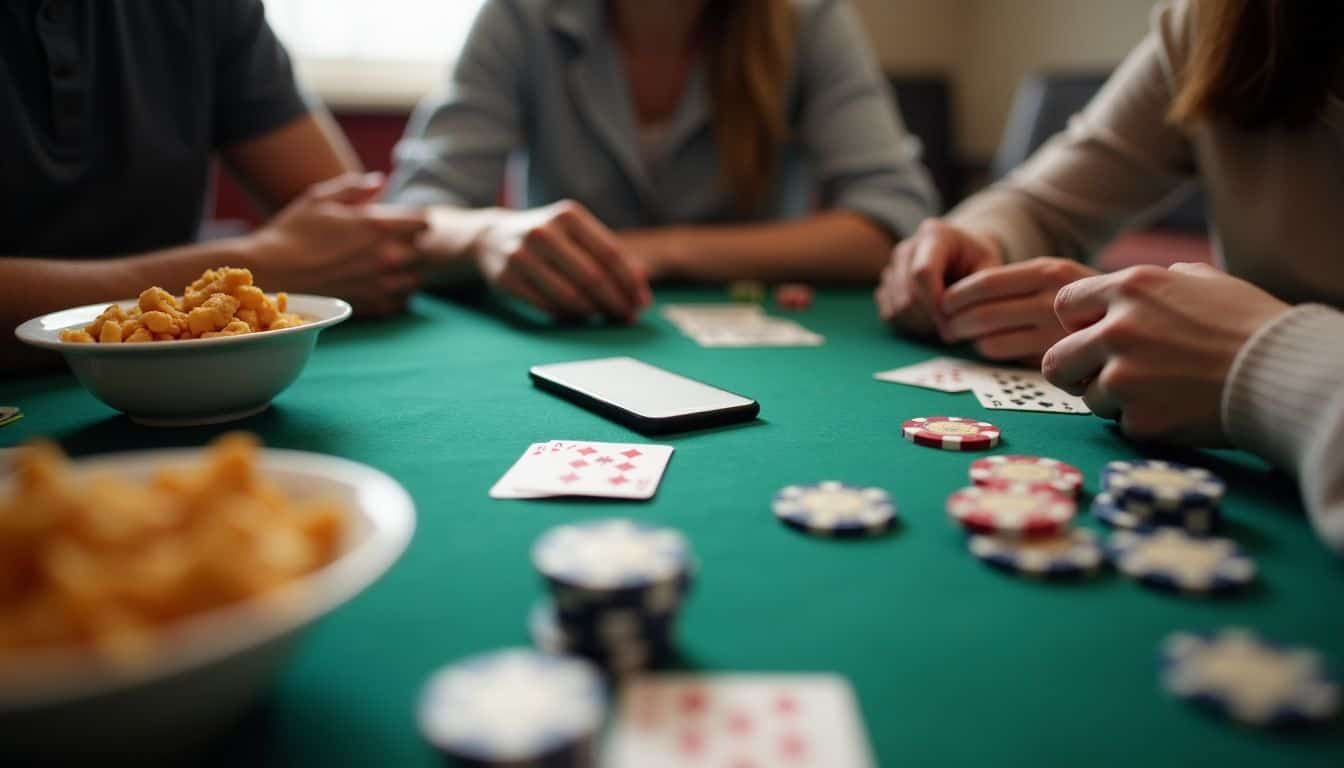
After all chips and cards return to their spots, spend a few minutes clearing snack bowls and drink cups. Later, text your friends—ask what they liked or would change for next poker night.
Cleaning the Space
Clear the poker table after your guests leave. Gather and separate trash like snack wrappers, empty bottles, or cups right away. Wipe down tables to remove drink spills and food crumbs using basic cleaning spray and paper towels.
Pack up game supplies such as cards, poker chips, chip racks, or card shufflers neatly in boxes so they’re easy to find next time.
Leave your space clean so it looks good as new—guests always notice a tidy area. Sweep floors quickly if chips or snacks have fallen underneath seating areas. Ensure furniture is back where it belongs before you move on to getting guest feedback from your poker night crew.
Gathering Feedback from Guests
After poker night wraps up, chat with your guests about the evening. Keep it short and casual—ask if they enjoyed the snacks, drinks, music, or games. Send out a quick thank-you message through your group chat or email list within one day after playing cards.
Post some fun photos from the event to keep everyone connected.
Chatting afterward sets you up for future poker gatherings too. By sharing highlights and laughs from this event online or in texts, you’ll build excitement for next time—and find out what friends liked most (or least).
The more you know about their thoughts on buy-ins, stakes, rules—or even seating—the better you’ll host later events. Let’s look ahead to see how hosting poker nights will change in 2025!
How Will Poker Night Hosting Evolve in 2025?

Poker nights in 2025 will focus on distraction-free gaming areas to boost player comfort and attention. Hosts will choose dedicated spaces away from everyday household interruptions, ensuring guests stay immersed in the poker action all night long.
Authenticity matters more than ever, so hosts will invest in full poker chip sets with at least 500 chips—creating a real casino feel for their buddies.
Hosts will use modern tools like the “Band” app to manage RSVPs easily and cut down on no-shows. Scheduling poker events regularly through these apps helps players plan better and commit fully—raising overall attendance.
Hosts will share clear house rules upfront with easy-to-find rule guides to resolve disputes quickly without hurting friendships or game flow. Snacks, drinks, comfy chairs, good music, and thoughtful themes remain key parts of planning great evenings that keep friends coming back eager for more rounds each session.
People Also Ask
What supplies do I need to host a poker night at home?
You’ll need playing cards, poker chips, and a sturdy table with enough seating for your guests. Don’t forget snacks and drinks—plus some upbeat music—to keep the atmosphere fun.
How can I set clear rules for my poker night without confusion?
Clearly explain the game type you’re playing—like Texas Hold’em or Five-Card Draw—and outline betting limits before you start dealing cards. Keep printed rule sheets handy to quickly settle any questions during play.
What’s an easy way to create a lively mood at my poker gathering?
Choose background music that fits your group’s taste, offer tasty finger foods everyone enjoys, and encourage friendly conversation between hands. A relaxed vibe helps players feel comfortable—and keeps things entertaining all evening long.
Should I offer prizes or rewards when hosting a casual poker event?
Yes! Small prizes like gift cards or simple trophies add excitement without breaking your budget. Friendly competition over modest awards makes the game more engaging and memorable for everyone involved.
References
https://pcpr.pitt.edu/author/cee53/?how-to-host-a-successful-poker-night-at-home (2025-03-17)
https://www.ignitioncasino.net/us/hosting-a-poker-night-at-home/
https://www.casinosupply.com/blogs/news/9-tips-for-setting-up-your-own-poker-game-at-home
https://www.gentlemansgazette.com/how-host-poker-night/
https://www.artofmanliness.com/skills/how-to/how-to-start-and-host-a-regular-poker-night/
https://www.pokerchipforum.com/threads/hosting-a-25-25-cash-game-providing-food-tips.123022/ (2024-08-21)
https://www.peerspace.com/resources/how-to-host-a-poker-night-tips-tricks-to-wow-your-friends/
https://pcpr.pitt.edu/author/cee53/?casual-poker-nights-tips-for-a-fun-game
https://www.fitandfunplayscapes.com/blogs/10-steps-to-planning-a-game-event (2024-12-31)
